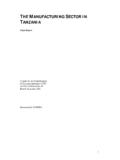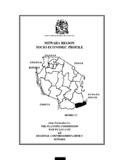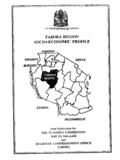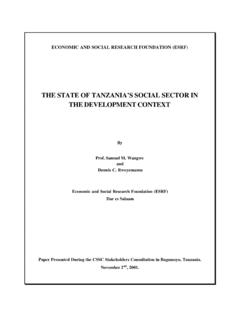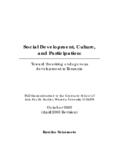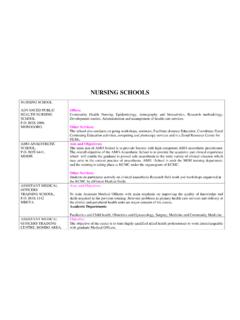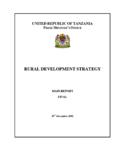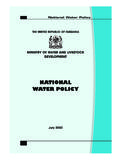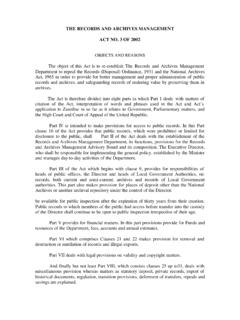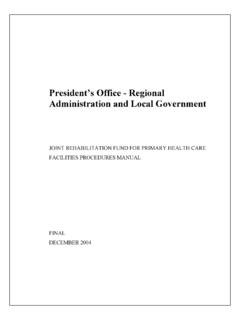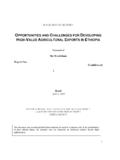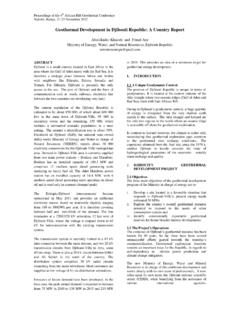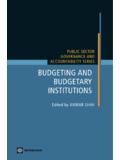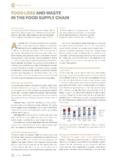Transcription of MBEYA REGION SOCIO-ECONOMIC PROFILE - Tzonline
1 KENYAUGANDARWANDABURUNDIZAMBIAMSUMBIJITH E UNITED REPUBLIC OF TANZANIAMBEYA REGIONSOCIO-ECONOMIC PROFILEJ oint Publication by:THE PLANNING COMMISSIONDAR ES SALAAMandREGIONAL COMMISSIONER'S OFFICEMBEYAMBEYA iTABLE OF CONTENTS Pages SECTION LAND POPULATION AND CLIMATE:..1 GEOGRAPHICAL LOCATION:..1 REGIONAL AREA AND ADMINISTRATIVE ADMINISTRATIVE DIVISIONS:..2 LAND USE:..4 (III) ETHNIC GROUPS:..7 (IV) POPULATION SIZE AND GROWTH:..7 POPULATION DENSITY AND DISTRIBUTION:..12 MIGRATION:..19 TOPOGRAPHY:..23 SECTION THE REGIONAL ECONOMY:..25 PRODUCTIVE Agriculture:..40 A. FOOD CASH CROPS:..45 IRRIGATION:..52 FARM IMPLEMENTS:..53 FARM INPUTS:..55 STORAGE DIARY CATTLE LIVESTOCK INFRASTRUCTURES:..65 NATURAL RESOURCES:..67 Introduction:..67 Afforestation:..70 Wildlife:..73 Beekeeping:..74 FISHING INDUSTRY:..78 MINING:..84 INDUSTRIAL ACTIVITIES:..85 SECTION ECONOMIC INFRASTRUCTURE.
2 88 ROAD NETWORK:..88 Introduction:..88 SOURCE: PLANNING COMMISSION - COMPILED DATA BASED ON DISTRICT SOCIO-ECONOMIC ROAD NETWORK MAP - MBEYA RAILWAY TRANSPORT:..95 AIR TRANSPORT:..95 WATER WAYS: (Marine Transport)..95 ENERGY:..96 ELECTRICITY:..96 FUELWOOD AND CHARCOAL:..97 SOLAR ENERGY:..98 BIO-GAS ENERGY:..98 COAL AND PADDY HUSKS:..98 POSTS AND TELECOMMUNICATION NETWORK:..98 SECTION SOCIAL EDUCATION:..101 PRIMARY EDUCATION:..101 PRIMARY SCHOOL DROP-OUTS:..120 SECONDARY SCHOOL ADULT iiiOTHER TRAINING INSTITUTIONS:..141 HEALTH SECTOR:..142 DISPENSARIES:..144 HEALTH CENTRES:..145 HOSPITAL SERVICES:..146 Mortality:..149 MATERNAL MALNUTRITION:..154 WATER (A) URBAN WATER SUPPLY:..161 RURAL WATER SUPPLY SCHEMES:..163 ENVIRONMENTAL SANITATION:..165 SECTION OTHER RELATED DEVELOPMENT ISSUES:..167 CO-OPERATIVE ACTIVITIES:..167 A. UNIONS:..167 PRIMARY CO-OPERATIVE SOCIETIES:..169 WOMEN IN DEVELOPMENT:..171 SECTION DEVELOPMENT POTENTIALS AND PROSPECTS.
3 175 AGRICULTURE:..175 IRRIGATION:..175 ANIMAL HUSBANDRY:..177 BEEKEEPING:..177 FISHING:..178 INDUSTRIES:..178 TOURISM:..179 MINING INDUSTRY:..181 ivANNEX GENERAL INFORMATION ABOUT AREA OF TANZANIA MAINLAND AREA BY regions (SQ KM)..186 LAND ARABLE LAND:..188 MOUNTAIN SUMMITS (METRES ABOVE SEA LEVEL)..188 (A) SOCIAL HEALTH EDUCATION: ENROLMENT RATES 1995 COMPARED WITH OTHER EAST AFRICA NATIONAL vFOREWORD 1. As we approach the 21st Century the problems facing rural areas in developing countries like Tanzania are numerous and formidable. Social and Economic services are deteriorating and proving to be unsustainable; school enrollment rates are declining; food situation is precarious; infant and maternal mortality rates continue to be high; unemployment is on the rise triggering off mass migration of youth from the rural areas into already overcrowded urban centres; in MBEYA REGION , for example, land pressure is escalating and deforestation is going on at an alarming rate.
4 2. This situation has arisen because of many factors including ill - prepared rural development programmes and weak monitoring and supervision of the implementation of development programmes and sectoral strategies. The observed shortcomings in the policy formulation, project identification, design, and implementation in the developing countries is in turn attributed to lack of reliable and adequate data and information on the rural development process. 3. The publication of Regional SOCIO-ECONOMIC Profiles series by the Planning Commission in collaboration with Regional Commissioner's offices should be viewed as a fruitful attempt towards finding solutions to the existing problem of data and information gap. 4. The Regional PROFILE series cover a wide range of data and information on geography, population, social economic parameters, social services, economic infrastructure and productive sectors.
5 The publications so far have proved to be of high demand and a vital source of information to many vipolicy makers, planners, researchers, donors and functional managers. The Planning Commission has found it a worthwhile effort to extend the exercise to cover even more regions . Readers are invited to make suggestions and constructive criticisms which can assist in improving the quality and effectiveness of future Profiles. 5. I would like to take this opportunity to acknowledge with thanks once again the financial support of the Royal Norwegian Embassy which facilitated the preparation of the MBEYA REGION SOCIO-ECONOMIC PROFILE . I would also like to thank both the Planning Commission and MBEYA Regional Planning Staff who put a lot of effort into ensuring the successful completion of this task. Nassoro W.
6 Malocho (MP) MINISTER OF STATE PLANNING AND PARASTATAL SECTOR REFORM April 1997 1 SECTION I LAND POPULATION AND CLIMATE: Geographical Location: MBEYA REGION originally belonged to the Southern Highlands Province. In 1963, the Southern Highalands Province was split into two regions namely, MBEYA and Iringa. In 1972, MBEYA REGION was extended to incorporate Sumbawanga District which before then belonged to the Western Province. However, the inclusion of Sumbawanga District into MBEYA REGION did not last long because in 1974 Sumbawanga District was separated and accorded full Regional status. It is located in the South Western Corner of the Southern Highlands of Tanzania. The REGION lies between Latitudes 7o and 9o 31% South of Equator, and between Longitudes 32o and 32o and 35o East of Greenwich. MBEYA REGION lies at an altitude of 475 metres above sea level with high peaks of 2981 metres above sea level at Rungwe higher attitudes.
7 MBEYA shares borders with countries of Zambia and Malawi to the immediate South; Rukwa REGION to the West; Tabora and Singida regions to the North; while Iringa REGION lies to its East, with Tunduma and Kasumulu in Mbozi and Kyela districts respectively being the main entries and/or exist into neighbouring countries of Malawi and Zambia. Regional Area and Administrative Units The Regional spacial area covers 63,420 which is of the total area of the United Republic of Tanzania. Out of the regional surface areas, 61,868 is dry land, about 57,000 arable land; and is covered with water. 2 Fig. 1: Distribution of surface area in sq. km, MBEYA REGION Dry land52%Water1%Arabel land47% Administrative Divisions: MBEYA REGION is divided in six Administrative districts namely Chunya, Ileje, MBEYA , Mbozi and Rungwe. However, the official establishment of the seventh district of Mbarali (curved from MBEYA District) is soon to be effected.
8 The districts are further divided into 25 divisions which are subdivided into 135 wards and 577 villages. 3 Table I: MBEYA REGION ADMINISTRATIVE UNITS BY DISTRICT Districts Area ( ) Regional Share (%) No. of Divisions No. of Wards No. of Village Chunya 29,219 4 22 34 Ileje 1,908 2 13 35 Kyela 1,322 2 14 82 MBEYA (R) 19,093 5 21 158 (Mbarali) (16,000) ( ) (2) (8) (71) MBEYA (U) 185 2 20 - Mbozi 9,679 6 26 141 Rungwe 2,211 4 30 136 Total 63,617 25 163 594 Source: MBEYA Regional Data Bank, 1996 Fig. 2: Distribution of land (sq. km) by District in MBEYA REGION 05,00010,00015,00020,00025,00030,000 4 LAND USE: Land in MBEYA REGION is put under different uses as Table II highlights. Table II: LAND CLASSIFICATION IN MBEYA REGION Classification Area in Area in Hectares Area Share (%) Arable Land 57,000 5,700,000 Game Reserves 99,.040 Forest Reserves 2,314 231,400 Water Bodies 1,757 175,700 Other Land Use (Settlement, in district etc) - 190;842 Total 63,617 6,361,700 100 Source: Planning Commission - Compiled Data from District Profiles Fig.
9 3: Land classifications in sq. kms, MBEYA Region010,00020,00030,00040,00050,00060, 000 ArableLandGameReservesForestReservesWate rBodies 5 Fig. 4: Land classification (Area thousands Ha.) in MBEYA REGION 01,0002,0003,0004,0005,0006,000 Table III below shows the intensity of land use in each District. One serious observation can be made in Table III. That is, in Kyela district all arable hectares of land are being utilised Table III: LAND USE BY DISTRICT IN MBEYA REGION District Arable land (Ha.) Land under Agriculture (Ha.) % of Land under Agriculture Game Reserve (Ha.) Forest Reserve (Ha.) Water Area (Ha.) Others (Ha.) Chunya 2,300,500 51,200 200,000 39,640 110,500 281,760 Ileje 101,600 350 - 6,050 - 83,150 Kyela 500,000 500,000 100 - 6,320 45,000 30,880 MBEYA (R) 572,089 211,420 37 500 46,623 - 1,290,088 Mbozi 766,640 421,652 55 93,738 - 29,200 78,322 6 Rungwe 166,820 67,420 40 - 4,450 - 49,830 Average Total Area 4,407,649 1,252,042 28 200,000 196,821 184,700 1,822,030 Source: Planning Commission Compiled Data for agricultural activities.
10 Unlike Chunya and Ileje districts where only and percent of their rable land are under agriculture respectively. ChunyaIlejeKyelaMbeya (R)MboziRungwe05001,0001,5002,0002,500 ChunyaIlejeKyelaMbeya (R)MboziRungweFig. 5: Arable land (Thousands Ha.) use by District MBEYA REGION 7 ChunyaIlejeKyelaMbeya (R)MboziRungwe-5050150250350450550 ChunyaIlejeKyelaMbeya (R)MboziRungweFig. 6: Land under Agriculture (Thousands Ha.) by District , MBEYA REGION (iii) Ethnic Groups: The indigenous tribes of MBEYA REGION are of Bantu Origin, who are believed to have moved into the REGION a long time ago. The ethnic groups in the REGION are Nyakyusa in Kyela and Rungwe Districts, Safwa, Malila and Sangu in MBEYA District, Nyika and Nyamwanga in Mbozi District, Ndali in Ileje District, and Bunguu and Kimbu in Chunya district. Between 1970 and 1990 there have been a significant inter-regional and intra-regional migration of tribes resulting into the Masai and Sukuma occupying Chunya and MBEYA Districts.
